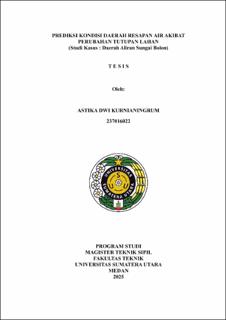Prediksi Kondisi Daerah Resapan Air Akibat Perubahan Tutupan Lahan (Studi Kasus : Daerah Aliran Sungai Bolon)
Prediction of Water Infiltration Area Conditions Due to Land Cover Change (Case Study: Bolon River Watershed)

Date
2025Author
Kurnianingrum, Astika Dwi
Advisor(s)
Mardianta, Anthoni Veery
Affandi, Oding
Metadata
Show full item recordAbstract
Massive land cover changes over the past two decades have significantly impacted the reduction of infiltration capacity, especially in areas experiencing intense development pressure. One such area is the Bolon Watershed (DAS Bolon) in North Sumatra, which has experienced a drastic decline in vegetative function due to land conversion into settlements and other built-up areas. This reduction in vegetation cover potentially decreases infiltration capacity, increases surface runoff, and elevates the risk of seasonal flooding and drought. Therefore, understanding the dynamics of land cover change and its impact on infiltration areas is crucial for sustainable land use planning.This study aims to predict the condition of infiltration areas in the Bolon Watershed over the next eight years using an integrated spatial-temporal approach. The methods applied include Cellular Automata–Markov Chain (CA-MC) modeling to forecast land cover changes, Weighted Multi Criteria Analysis (WMCA) based on Analytic Hierarchy Process (AHP), and the integration of Artificial Neural Network (ANN) to model nonlinear relationships among environmental factors. WMCA-AHP incorporates key environmental parameters such as land cover, slope, rainfall, and soil texture, each weighted based on expert judgment. The AHP results indicate that land cover is the most dominant factor with a weight of 48%, followed by soil texture (28%), slope (19%), and rainfall (5%). The Consistency Ratio (CR) value of 0.08 indicates that the assessment meets acceptable consistency criteria. Historical land cover analysis shows that the largest conversion occurred from plantation to settlement, covering 55.17 km². WMCA modeling for the 2029–2033 period reveals a significant increase in the very low infiltration class from only 0.07 km² to 59.68 km². Although the high infiltration class remains dominant, this downward trend reflects degradation in infiltration capacity due to uncontrolled urbanization. These findings underscore the importance of implementing conservation policies and predictive spatial planning to maintain the hydrological function of the watershed.
Collections
- Master Theses [278]
